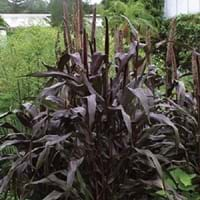Life Span
Annual and Perennial
Biennial
Types
Not Available
Not available
Habitat
Sunny Edge, Warmer regions
Forests, meadows, Pastures, Prairies, savannahs, Woodland edges
USDA Hardiness Zone
8-11
8-10
AHS Heat Zone
12 - 8
10-6
Sunset Zone
8, 9, 10, 14, 15, 16, 17, 18, 19, 20, 21, 22, 23, 24
H1, 8, 9, 12, 13, 14, 15, 16, 17, 18, 19, 20, 21, 22, 23, 24
Habit
Upright/Erect
Upright/Erect
Flower Color
Brown, Purple, Purplish-black
White, Lemon yellow, Light Pink
Flower Color Modifier
Bicolor
Bicolor
Fruit Color
Brown, Cream
Tan
Leaf Color in Spring
Purple, Dark Green, Burgundy
Green
Leaf Color in Summer
Light Green
Green
Leaf Color in Fall
Purple, Dark Green, Burgundy
Not Available
Leaf Color in Winter
Not Available
Light Green
Leaf Shape
Long Linear
Alternate
Plant Season
Spring, Summer, Fall
Spring, Summer
Sunlight
Full Sun
Full Sun, Partial Sun
Growth Rate
Very Fast
Fast
Type of Soil
Loam, Sand
Loam, Sand
The pH of Soil
Neutral, Alkaline
Neutral, Alkaline
Soil Drainage
Well drained
Well drained
Bloom Time
Summer, Late Summer, Early Fall, Fall
Early Spring, Spring, Late Spring, Early Summer, Late Winter
Tolerances
Not Available
Drought
Where to Plant?
Container, Ground, Pot
Container, Ground, Pot
How to Plant?
Seedlings
Seedlings
Plant Maintenance
Medium
Medium
Watering Requirements
Requires regular watering
Average Water Needs, Do Not over Water, Keep the Soil well drained, Requires regular watering
In Summer
Lots of watering
Lots of watering
In Spring
Moderate
Moderate
In Winter
Average Water
Average Water
Soil pH
Neutral, Alkaline
Neutral, Alkaline
Soil Type
Loam, Sand
Loam, Sand
Soil Drainage Capacity
Well drained
Well drained
Sun Exposure
Full Sun
Full Sun, Partial Sun
Pruning
Prune in winter, Remove damaged leaves, Remove dead branches, Remove dead leaves
Remove damaged leaves, Remove dead branches, Remove dead leaves
Fertilizers
15-0-15, All-Purpose Liquid Fertilizer
All-Purpose Liquid Fertilizer
Pests and Diseases
Alternaria Leaf Spot, eyespot, Red blotch
Pests and diseases free, Red blotch
Plant Tolerance
Deer resistant, Drought
Drought
Flower Petal Number
Single
Single
Foliage Texture
Coarse
Medium
Foliage Sheen
Not Available
Matte
Invasive
Sometimes
Sometimes
Attracts
Aphids, Bees, Birds
Bugs, Butterflies, Insects
Allergy
Unknown
Abdominal pain, Anxiety, Inflammation, Low blood pressure
Aesthetic Uses
along a porch, deck or patio, Beautification, Informal Hedge, Mixed Border, Showy Purposes, Wild gardens
Beautification, Decorating walls, Hanging Basket, Showy Purposes, Used as an interior landscaping species, Used for decorating walls, fences, gates, hedges, etc.
Beauty Benefits
No Beauty Benefits, Not Available
Skin irritation, Skin Problems
Environmental Uses
Air purification
Air purification
Medicinal Uses
Not Available
Eczema, Menstrual Cramps, Menstrual Disorders
Part of Plant Used
Branch, Flowering Tips, Whole plant
Flowers, Root, Seeds, Stem
Other Uses
Beneficial species for attracting pollinators, repels deer
Beneficial species for attracting pollinators, deer resistant, Edible seed
Used As Indoor Plant
No
Yes
Used As Outdoor Plant
Yes
Yes
Garden Design
Bedding Plant, Container, Cutflower, Dried Flower/Everlasting, Mixed Border
Mixed Border, Rock Garden, Wall, Wildflower
Botanical Name
PENNISETUM glaucum 'purple millet'
OENOTHERA mexicana
Common Name
Millet, Pearl Millet
pinkladies, pink evening primrose, showy evening primrose, Mexican primrose, and amapola.
In Hindi
purple millet
Mexican primrose
In German
purple millet
Rosa Nachtkerze
In French
millet pourpre
Mexican primrose
In Spanish
purple millet
Primrose mexicana
In Greek
purple millet
Μεξικού Primrose
In Portuguese
purple millet
Mexican Primrose
In Polish
purple millet
Mexican Primrose
In Latin
purple millet
Mexicanus Primrose
Phylum
Magnoliophyta
Tracheophyta
Class
Liliopsida
Magnoliopsida
Family
Poaceae
Onagraceae
Genus
Pennisetum
Oenothera
Clade
Angiosperms, Commelinids, Monocots
Angiosperms, Eudicots, Rosids
Subfamily
Panicoideae
Onagroideae
Number of Species
Not Available
Season and Care of Purple Millet and Mexican primrose
Season and care of Purple Millet and Mexican primrose is important to know. While considering everything about Purple Millet and Mexican primrose Care, growing season is an essential factor. Purple Millet season is Spring, Summer and Fall and Mexican primrose season is Spring, Summer and Fall. The type of soil for Purple Millet is Loam, Sand and for Mexican primrose is Loam, Sand while the PH of soil for Purple Millet is Neutral, Alkaline and for Mexican primrose is Neutral, Alkaline.
Purple Millet and Mexican primrose Physical Information
Purple Millet and Mexican primrose physical information is very important for comparison. Purple Millet height is 90.00 cm and width 30.50 cm whereas Mexican primrose height is 15.20 cm and width 25.40 cm. The color specification of Purple Millet and Mexican primrose are as follows:
Purple Millet flower color: Brown, Purple and Purplish-black
Purple Millet leaf color: Purple, Dark Green and Burgundy
Mexican primrose flower color: White, Lemon yellow and Light Pink
- Mexican primrose leaf color: Green
Care of Purple Millet and Mexican primrose
Care of Purple Millet and Mexican primrose include pruning, fertilizers, watering etc. Purple Millet pruning is done Prune in winter, Remove damaged leaves, Remove dead branches and Remove dead leaves and Mexican primrose pruning is done Remove damaged leaves, Remove dead branches and Remove dead leaves. In summer Purple Millet needs Lots of watering and in winter, it needs Average Water. Whereas, in summer Mexican primrose needs Lots of watering and in winter, it needs Average Water.





